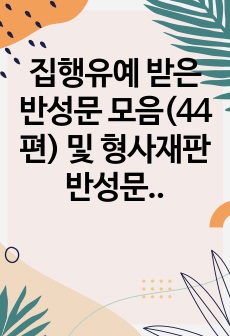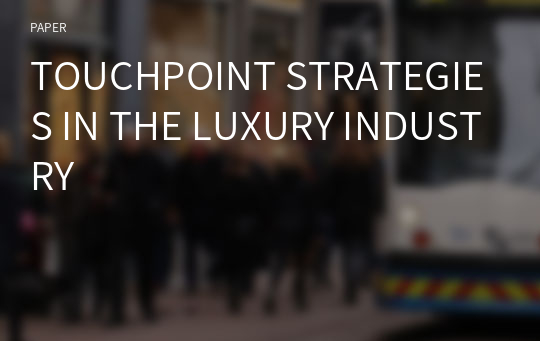TOUCHPOINT STRATEGIES IN THE LUXURY INDUSTRY
* 본 문서는 배포용으로 복사 및 편집이 불가합니다.
서지정보
ㆍ발행기관 : 글로벌지식마케팅경영학회(GFMC)
ㆍ수록지정보 : GFMC Session1
ㆍ저자명 : Lara Haug, Benjamin Berghaus
ㆍ저자명 : Lara Haug, Benjamin Berghaus
영어 초록
Recent years have brought along a significant increase of possibilities to get in touch and interact with potential and current customers (Neslin et al., 2006; Lemon & Verhoef, 2016). Especially the rise of digital media as well as sales channels has added new challenges and general complexity to the management of customer interactions (Brynjolfsson, Hu, and Rahman, 2013; Lamberton & Stephen, 2016). At the same time, consumers’ preferences regarding how, where, and when to get in touch with brands, be approached by, and interact with them are changing (Edelmann, 2010; Batra & Keller, 2016; Sherman, 2017). At the forefront of this trend are consumers of the millennial generation, who are stereotyped to be much more connected, social media present, and impatient than previous generations (Fromm & Garton, 2013; Goldman Sachs, 2016). For luxury brands the challenge is particularly difficult. They want to provide the best experience to their consumers to underpin their exclusiveness (Atwal & Williams, 2009; Kapferer, 1996; Kapferer, 2014) at the same time they are facing a high risk of inconsistency across touchpoints. Their limited experience with digital touchpoints reinforce the challenging task even further (Okonkwo, 2009; Heine & Berghaus, 2014). Not reacting does not seem to be an option in light of the market developments. Following every trend and being present in every possible channel does not appear to be the most compelling strategy either. It raises the risk of inconsistency and badly managed interactions. Rather, companies need to define goals along the customer journey, pick the right touchpoints and manage them in a way to reach those goals, and deduct strategies to provide an integrated customer experience. The question arises how can brands successfully exploit touchpoint strategies to engage Millennials in the luxury market? Most published studies focus on specific groups of touchpoints and conclude that a more holistic understanding of customer interactions is needed (Baxendale, Macdonald & Wilson, 2015; Verhoef & Lemon, 2016). Also in the luxury segment, research has mainly explored the new digital touchpoints or the retail channel in particular, but not taken a holistic view discussing overall touchpoint strategies (e.g. Kim & Ko, 2012; Heine & Berghaus, 2014; Lee & Watkins, 2016). We aim to close this gap by taking a strategic view on touchpoint management and its goals focusing on the luxury industry and Millennial consumers as a customer group to secure a forward-looking perspective. Based on Baxendale et al. (2015) we define a touchpoint as each direct or indirect interaction of a consumer with a brand. This means that brand to consumer as well as consumer to consumer and third party to consumer interactions are included in our understanding, which appears to be highly relevant in light of the high importance of word of mouth referrals for luxury brands and the increasing relevance of bloggers and influencers. To understand which touchpoints should and can be used for which purposes, we first want to understand what goals companies pursue along the customer journey and then deduct which touchpoints can help them accomplish those goals. Is a brand website for example a tool that should convert customers to buy or is it rather an information tool that nurtures awareness in the pre-purchase phase? Depending on the answer, the content and website design as well as the definition what constitutes success for the website presence need to be fundamentally different. If the goal has not been defined in advance, the management of the website may appear difficult as different directions may be pursued. To shed light on these challenges, we use a literature review to develop a semi-structured interview guide. We then speak to industry experts to learn more about the goals they pursue in each phase of interaction with consumers along the customer journey. We deduct the types of interactions that are the most fruitful to successfully perform these interactions. This way, we aim to deduct first insights into the management of touchpoints. These can later on be further deepened.참고 자료
없음"GFMC Session1"의 다른 논문
 FAST AND SLOW FASHION BRANDS IN DEVELOPING SUSTAINABLE ..6페이지
FAST AND SLOW FASHION BRANDS IN DEVELOPING SUSTAINABLE ..6페이지 “WHAT IF A CELEBRITY AND A BRAND CO-CREATE A NEW COLLEC..7페이지
“WHAT IF A CELEBRITY AND A BRAND CO-CREATE A NEW COLLEC..7페이지 THE INSTAGRAM’S STRATEGY IN ENGAGING THE CUSTOMER’S LOY..3페이지
THE INSTAGRAM’S STRATEGY IN ENGAGING THE CUSTOMER’S LOY..3페이지 THE PARTICULARITIES OF NEW PRODUCT DEVELOPMENT IN THE T..5페이지
THE PARTICULARITIES OF NEW PRODUCT DEVELOPMENT IN THE T..5페이지 THE LONE CHOCOLATE BAR: THE INFLUENCE OF PERCEIVED SCAR..6페이지
THE LONE CHOCOLATE BAR: THE INFLUENCE OF PERCEIVED SCAR..6페이지 ADS AS WORKS OF ART: MEASURING ADVERTISING IMMERSION3페이지
ADS AS WORKS OF ART: MEASURING ADVERTISING IMMERSION3페이지 ECONOMIES OF SMALL: NICHE STRATEGIES AND SUCCESS FACTOR..8페이지
ECONOMIES OF SMALL: NICHE STRATEGIES AND SUCCESS FACTOR..8페이지 THE INFLUENCE OF ONLINE CUSTOMER REVIEWS ON RETAILERS' ..6페이지
THE INFLUENCE OF ONLINE CUSTOMER REVIEWS ON RETAILERS' ..6페이지 IS THE ARTIFICATION PROCESS PERCEIVED BY FINAL CONSUMER..6페이지
IS THE ARTIFICATION PROCESS PERCEIVED BY FINAL CONSUMER..6페이지 THE ODD EVEN PRICE PARADOX IN THE FASHION LUXURY SECTOR6페이지
THE ODD EVEN PRICE PARADOX IN THE FASHION LUXURY SECTOR6페이지


























